Much of a nation’s culture resides in its cuisine. Although grilling and smoking meat has been done since before recorded time on all continents, although every cuisine has its mother sauces, barbecue sauces are distinctly American.
To most Americans, barbecue sauce is red, sweet, and smoky and it comes from a shelf near the ketchup. To those who travel and would rather lunch in back of a rickety shack under a shade tree than under the golden arches, barbecue sauce comes in a rainbow of colors and flavors, and most are tied to the area of origin and its ethnic roots. Barbecue sauce is thick with American history and culture.
Just look at the Carolinas for proof. In the eastern half of North Carolina barbecue sauce is practically transparent with cayenne pepper flakes that flurry in the bottle like a snow globe. In western half of the state it is pink going on garnet from tomato sauce. In much of South Carolina it is yellow from mustard, popular with German settlers.
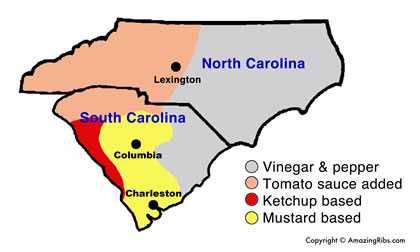
To add a patriotic flair to your next cookout, serve your guests a choice of several sauces from around the nation.
Make your own sauces
Below are 12 Benchmark Barbecue Sauces with links to my recipes. Making barbecue sauce is great fun. Standing over the pot adding a dash of this, a pinch of that, taking a taste, adjusting, sipping, and adding something else makes one feel like a wizard. If you don’t want to make your own but you still want to taste the range of styles, I have selected a dozen benchmarks, every one actually comes from the region. Many of my selections come from joints that should be on your bucket list. Each has earned my Gold Medal. You may not like them all if you only taste them from the bottle, but they are designed to go on meat, often specific meat. Try them all and try to serve them as they are served in their home town and enjoy a taste America’s diverse culinary culture.

Kansas City Sweet Red Sauce
This thick red stuff is what most of think of when someone says “barbecue sauce”. The most popular are KC Masterpiece and Sweet Baby Ray’s. The best are brass bands with multiple layers from several sources of sweetness (tomato paste or ketchup, brown sugar, molasses, and/or honey); multiple sources of tartness (among them vinegar, lemon juice, hot sauce, and steak sauce); multiple sources of heat (American chili powder, black pepper, mustard, and hot sauces are common); and they get layers of flavor from all the above as well as Worcestershire, garlic, onion, cumin, and salt. Many have liquid smoke added to help create that outdoor flavor for folks who cannot cook outdoors. Many are just amped up ketchup, like this sauce from former president LBJ’s favorite pitmaster Walter Jetton.
Interestingly, the first Kansas City barbecue sauces were probably hot, mostly vinegar and pepper. Evidence is that this was the case for Henry Perry’s sauce, and he started it all in 1907 in the city that is known as the capital of barbecue in the world.
Now that I’ve defined the genre, let me point out an important exception to the rule: Arthur Bryant’s Original Barbeque Sauce. Arthur Bryant’s has been one of the iconic barbecue joints since 1930, perhaps the most holy of them all in the city that means barbecue more than any other, and they have been making a tomato based sauce that is thick, intense, with a solid black pepper and garlic theme. No noticeable sweetness or liquid smoke flavor. Nada. This is probably because the Arthur and Charlie Bryant were disciples of Perry.
Serving
KC Sauce is my favorite for pork ribs and that’s where it shines in KC. Try it on burgers or meatloaf. KC Sauces are thick and they sit on top of the meat, not penetrating very far. For this reason you need just one or two coats. Let the meat shine through. They also burn easily, so paint your meat no sooner than 15 minutes before serving.
Make your own
My KC Classic recipe, inspired by KC Masterpiece, is mighty tasty and caramelizes beautifully over a hot fire.
Buy a benchmark: Three Little Pigs Kansas City Competition Sauce from Overland Park, KS
Made in a suburb of Kansas City, Three Little Pigs Kansas City Competition is prototypical, from one of the top teams on the competition circuit. Thick and brown with golden edges, with a definite sweetness that is not enough to make it gooey, there are black pepper chunks and pepper seeds clearly visible, a hint of cumin, complex, with a long peppery finish. If you finish ribs with it and give it a minute over high heat it sizzles and caramelizes beautifully. One of the things I like about it is that it is not dominated by liquid smoke as are so many others. You can get your smoke on the grill or smoker! TLP started as a caterer and championship BBQ competition team, created The Good One grills and smokers (among my faves), and now has a restaurant in Kansas City’s Crowne Center.
Click here to order it on Amazon

South Carolina Mustard Sauce
The most distinctive sauce in the Carolinas, and by far my fave, is the mustard based sauce found in barbecue joints from Columbia to Charleston. Mustard and pork go together like peanut butter and jelly. Early German immigrants in South Carolina knew this and the names of many of the best barbecue joints that serve mustard sauce have German names, like Shealy, Sweatman, Meyer, and Zeigler. The classic SC mustard sauces are a runny mix of yellow mustard, vinegar, sugar, and spices. Simple but very effective. There are also pockets of Georgia where the mustard sauce has taken hold.
Serving
This is my favorite sauce for pork chops, pulled pork, and hot dogs, brats, and Polies.
Make your own
I offer my South Carolina Mustard Sauce as my personal riff on the theme.
Buy a benchmark: Maurice’s Southern Gold, Columbia, SC
Maurice’s Piggie Park restaurant is a landmark and destination dining. The sauce is mustard forward but it is slightly sweet and spicy and herbal.

East Carolina Mop-Sauce
On the coast of North and South Carolina, a.k.a. “East Carolina” or the “Low Country”, the philosophy is “Whole hog and keep the mustard for your hot dogs and the ketchup for your fries.” The African slaves of the Scottish settlers in the region pioneered American barbecue and their simple sauces were plain a kiss of hot pepper flakes and ground black pepper in vinegar. And so they remain today, where the sauce is used both as a mop or baste on the meat while it is cooking, and then as a finishing sauce at tableside. Thin and piquant, they are designed to penetrate the meat, not just sit on top as thicker ketchup and mustard sauces do so they are used both as a baste during cooking as well as a finishing sauce. They do a great job of cutting the fat in lipid-laced pork. There is little or no sugar in the mix, so your kids will hate it.
Serving
This sauce is superb on fatty foods and makes whole hog, pork shoulder, and lamb shoulder come to life.
Make your own
Try my recipe for East Carolina Kiss & Vinegar on just a bit of your chopped pork before your pour it over the whole sandwich, and if don’t like it, send the leftovers to me.
Buy a benchmark: Scott’s Barbecue Sauce from Goldsboro, NC
Scott’s Family Barbecue Sauce goes back to 1917 when Adam Scott first got into the barbecue business in Goldsboro. A local minister, Scott said the exact ingredients in the sauce were revealed to him in a dream. That original sauce recipe was served on Scott’s barbecue for nearly 30 years, until 1946 when Adam’s son, A. Martel Scott, Sr., spiced up the mixture a bit. Interestingly, they don’t have a restaurant, just a sauce business. Today Scott’s is nothing but vinegar, water, salt, peppers, and a few other spices (shake well). Tangy from the vinegar, spicy, but not scorchin’, this is the kind of stuff that made North Carolina barbecue famous. You will not like it straight from the bottle. Sprinkle it on pulled pork and then tell me what you think. It is a perfect example of 1 + 1 = 4.
Click here to order it on Amazon
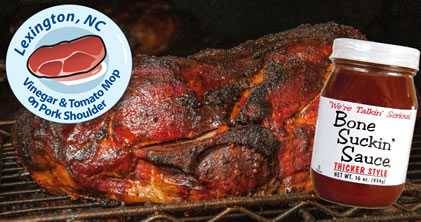
Lexington Dip (a.k.a. Western Carolina Or Piedmont Dip)
In Lexington, NC, and in the “Piedmont” hilly areas of the western Carolinas, they prefer to make their barbecue from the pig’s shoulder, a rich flavorful clod of meat. In North Carolina, otherwise kindly old men have been moved to fisticuffs over the question of whether barbecue is properly made from whole hog or shoulder. In Lexington and west, they often call their mop-sauce “dip”. It is vinegar and pepper based, a lot like the East Carolina mop-sauce, but laced with a hint of tomato sauce or ketchup added, not a lot. The red stuff helps tame the fierceness of the vinegar a bit, and the hint of sweetness counterbalances the acidity. I prefer it slightly to the East Carolina style.
Serving
Serve it on all forms of pork, chicken, or turkey.
Make your own
My recipe for Lexington Dip uses a bit of apple juice, a veer from the standard, but I stole the idea from George’s, made in Nashville, NC. It really adds depth.
Buy a benchmark: Bone Suckin’ Sauce, Thicker Style from Raleigh, NC
Created in 1975, Bone Suckin’ Sauce, the original (not the thicker style) is mostly vinegar laced with hot red pepper, black pepper, and a whisp of ketchup. I chose the Thicker Style for this sampler because, frankly, it is more versatile. It has a fresh tomato flavor, not a ketchup flavor, and I find that a refreshing old fashioned change of pace.
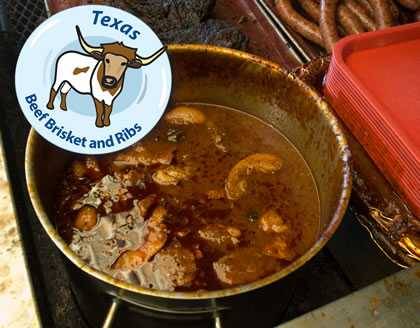
Texas Mop-Sauce
In Texas they barbecue pork and beef ribs, pulled pork, chicken, mutton, goat, and sausage they call “hot guts”, but the stars of the Lone Star State is beef brisket and beef ribs. Brisket is an impossibly tough cut from the chest area that is magically converted to buttah-like tenderness with 12 to 18 hours of low and slow smoke roasting. It is usually sliced about 1/4″ thick across the grain and served on butcher paper or in a white bread sandwich. Beef ribs are about 2″ wide, 3″ thick, and 6″ long. Or bigger. And you just chomp like you would pork ribs. Please don’t ask for a knife and fork.
There are three important culinary influences on Texas barbecue:
1) European immigrants who brought expertise in smoking meats, especially Germans, Czechs, and Hungarians
2) Freed slaves from the Southeast, and
3) Mexicans (Texas was, after all, a part of Mexico, and its cuisine leans heavily on Spanish, Mayan, and Aztec cultures).
Some traditional Texas pitmasters use their sauce as both a mop to cool and moisten the meat during direct cooking, and as an optional finishing sauce. Most common are thin, tart mops that are flavored with vinegar, American chili powder or ancho powder, lots of black pepper, cumin, hot sauce, fresh onion, and only a touch of ketchup. Traditional Texans and Mexican Americans, who do a lot of the cooking, don’t cotton to sloppy, sticky, ketchup-based sauces like they make up north. That’s because cattle don’t need sugar any more than they need wolves. The traditional sauces are thin, almost a gravy or soup that works both as a mop during the cook, and as a simple finishing sauce. Alas, nowadays most have been influenced by the popularity of Kansas City sauces, and have gotten redder and sweeter.
Some of the best sauces have beef drippings, and therefore cannot be bottled. As a result, the stuff served in the traditional old restaurants is vastly different than the stuff sold in bottle. In hallowed joints like Cooper’s, in Llano, they often resemble a thin tomato soup with a beef stock base. They penetrate the meat easily rather than sit on top. I prefer them on brisket, not pork. In this picture, the bottled sauce sold at Cooper’s is poured into a large pot and is kept warm on the holding pit. Trimmings are tossed in the pot, and when you order, if you ask for sauce, the meat is dipped in the pot. It tastes a LOT different than the bottled sauce served on the tables.
Before the meat is cooked, it is seasoned with a Texas Dry Rub, formulated for brisket with little or no sugar, lots of black pepper, and so they are very different from Memphis and most other rubs.
Serving
Perfect for brisket, low slow beef ribs, mutton, or goat. Follow their advice and throw some fat trimmings on the pit with your meat, cook them, capture the smoky drippings, and add them to the sauce.
Make your own
Try my Texas Mop-Sauce for a taste of a real old-fashioned-hard-to-find-anymore-down-on-the-ranch Texas barbecue mop and sauce.
Buy a benchmark: Cooper’s Old Time Pit BBQ Sauce (Llano, TX)
Sadly, Americans demand sweet sauces so most of the old style sauces have disappeared, with one notable exception. The legendary Cooper’s Old Time Pit Bar-B-Que in tiny isolated Llano, pictured here has a dozen pits to cook in, and one pit that is a holding pit. It has hunks of each of their meats that have just finished cooking, and a big bucket of sauce with trimmings floating in it. Customers come up and point at the meat they want and if they want sauce, the meat is dunked in the bucket, flavoring both. People love this place so much that they often come for lunch in their private planes and corporate helicopters.
Their sauce is about as close to a throwback as you can find, close to a thin vinegary based Bloody Mary mix. They recommend you shake it well, heat it and add cooked fat from trimmings, oil, or butter and heat for several hours. Just like they do. Use it sparingly.
Click here to order from Cooper’s

Alabama White Sauce
Big Bob Gibson Bar-B-Que, in upstate Decatur, Alabama, has been a popular local hangout since 1925. Their signature mayonnaise and vinegar based white barbecue sauce for chicken is their most famous because it is something Big Bob himself invented in the early years, although it now has several imitators.
Serving
You have to try this on grilled or smoked chicken or turkey.
Make your own
Chris Lilly of Big Bob’s says my attempt to reverse engineer his Alabama White Sauce is “scary close”.
Buy a benchmark: Big Bob Gibson Bar-B-Q Original White Sauce from Decatur, AL
In the past decade Big Bob’s has achieved national fame on the coattails of the acclaim slathered on Chef Chris Lilly and his Big Bob Gibson Bar-B-Que competition team. The birds are dunked in a vat of sauce and then go in a beer cooler where the sauce mixes with the smoke and seasonings on the surface of the meat before it is served. And that’s how to use it. When the bird is almost done smoking or grilling with indirect heat, slather it on generously, let it settle in, and serve.
Click here to order it on Amazon
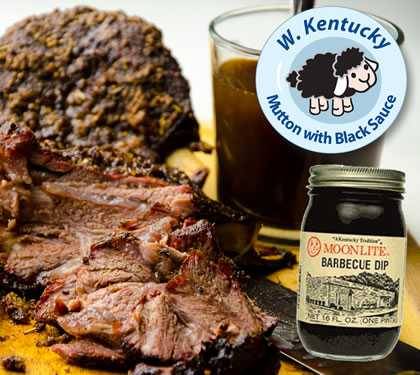
Kentucky Black Barbecue Sauce and Dip
The most obscure of the regional American barbecue sauces is the Kentucky Black Barbecue Sauce & Dip because it can be found only in restaurants in a small area of Western Kentucky around Owensboro. A fascinating blend is mostly distilled white vinegar and Worcestershire sauce, it is designed to go with the specialty of the region, slow smoked mutton (mature lamb), but it is also used on chicken and other meats. It is used as a baste on the pit, and then as a finishing sauce.
When a lamb is more than one year old and no longer producing enough wool, it is slaughtered and the meat is called mutton. It has a strong, distinctive, gamier taste than younger, more succulent lamb. As with so many other barbecue meats such as pork ribs and beef brisket, mutton found its way onto the low and slow smoker because it is tough, full of connective tissue, and less desirable than lamb.
In the 1800s Kentucky was the largest lamb producing state, but it has now fallen to number 34. The tradition of barbecue mutton lives on in dozens of barbecue joints and church socials. The cuts of choice are shoulder and rear leg. The loin is reserved for grilling and served medium rare sans sauce.
Serving
Kentucky Black Sauce is specially designed for smoked mutton shoulder, although lamb will do. Cook it just like pulled pork, just baste it with black sauce and serve it on the side. You will not like it straight from the bottle, so don’t even try it.
Make your own
Founded in 1949, Moonlite Bar-B-Que Inn is by far the most famous western Kentucky BBQ restaurant and it draws devotees from many miles away. They have two slightly different recipes, one for basting, and one for serving. My Sunlite Kentucky Black Barbecue Sauce & Dip For Lamb And Mutton is both a baste and finishing sauce.
Buy a benchmark: Moonlite Original Bar-B-Q Sauce from Owensboro, KY
This fascinating sauce is a quirky blend is mostly vinegar and Worcestershire sauce. The meat is prepared in a similar fashion to pulled pork, basted with the thin sauce that enters all its the openings it can find while it is cooking, but it is usually not shredded, it is sliced and doused again.
Click here to order from Moonlite
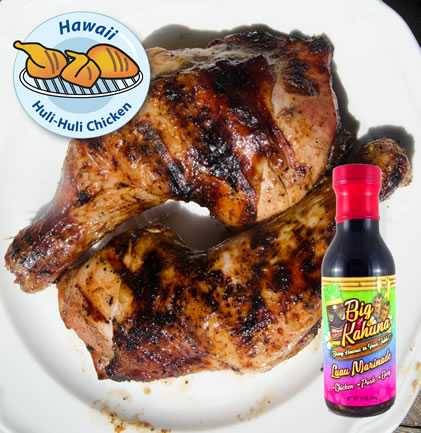
Hawaiian Huli-Huli Teriyaki Sauce
In 1955 Ernest Morgado cooked up a big batch of chicken for a farmer’s group. It had been marinated in his rrendition of Japanese Teriyaki Sauce, and painted with the sauce on the grill. It was such a hit that, by the time he died, it had become a signature dish beloved throughout Hawaii, served mostly by shade tree cooks from roadside stands, parking lots, and parks at fundraisers. Drive around Oahu and if you see smoke rising and smell something sweet, it is likely Huli-Huli chicken. The locals keep napkins in their glove compartment just in case.
Rather than turn scores chicken pieces one by one when he was catering an event, he sandwiched the meat between two mesh grates, and, with the help of an assistant, flipped the whole contraption. Sort of Hawaiian rotisserie. When it was time to turn, he would shout “huli” which is Hawaiian for “turn” to his assistant who would shout “huli” back, grab the handles on the other side of the grates, and turn the chicken over, lickety split. Huli-Huli Chicken was born.
Huli-Huli Sauce was originally a teriyaki sauce, which, in Japan, is a simple blend of soy sauce, mirin (a sweet rice wine), and a little sugar reduced to a glaze.
Serving
Huli-Huli is designed for chicken, but it works great on turkey, tuna steaks, pork chops, andpork tenderloin beautifully. Use it on Asian stir fries wherever teriyaki sauce is called for.
Make your own
Every vendor on the islands has his or her own secret recipe, so here’s my interpretation.
Buy a benchmark: Hawaii’s Famous Huli-Huli Sauce Honolulu, HI
This salty soy sauce base leads with a lively ginger punch and is balanced by sweetness. It is used as both a marinade and a baste. Grill indirect until it is not quite done, and then finish over direct heat with the lid up, turning frequently so it doesn’t burn.
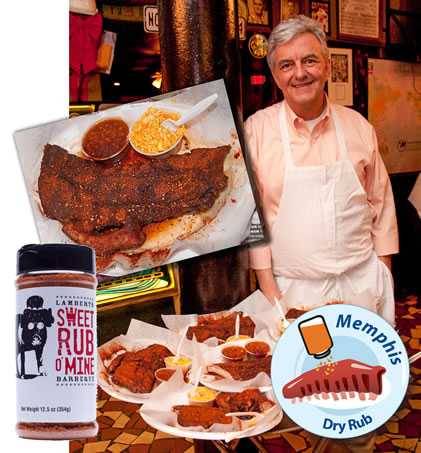
Memphis Dry Rub
Rubs are spice mixes that you can apply to raw food before cooking. The best are designed to enhance the meat or vegetables by melting into the juices that come to the surface during cooking. Each is formulated for the substrate. For example, poultry and fish rubs tend to be mostly herbs, while pork rubs are mostly spices.
In most BBQ joints the rub gets buried beneath the sauce. But in Memphis many barbecue joints offer you the choice of “wet” or “dry” ribs. Both have a rub applied to the ribs before cooking, but dry ribs get no sauce, wet ribs do. Some even put a finishing sprinkle or rub on the meat just before serving as they do at the famous Rendezvous, above. Even if you like your pork wet a good rub adds flavor, texture, and color, and you need one if only so, when you are asked “What’s your secret?”, you can answer, as the pros do, by saying “It’s my rub, man.”
The best pork rubs contain sugar to melt and help form the bark, paprika for color, black pepper for zing, onion and garlic for savory, and more. Because most rubs contain salt, some pros leave their rub on overnight, sort of a dry marinade, that can work like a dry brine. Some put it right on the meat and then massage it in. Others lay down a mustard base first to act like glue. I just lightly wet the surface so the spices will start to dissolve, and lay it on thick, but not so thick that you can’t see meat beneath it.
Serving
This dry rub is superb on all pork and good enough that it doesn’t need sauce. Try it on salmon, popcorn, or the rim of a bloody Mary too.
Make your own
Memphis dry rubs are usually paprika based, and typical ingredients are salt, garlic, onion, black pepper, American chili powder, and oregano. Meathead’s Memphis Dust is a very versatile recipe perfect for pork, but readers have told me they love it on everything from turkey to salmon.
Perhaps the most revered dry ribs are served at Charlie Vergos’ Rendezvous (called “The Vous” by some of the locals). There are a lot of recipes on the internet that the owners have palmed off on gullible media. They aren’t close. I’ve reversed engineered Rendezvous-style Memphis Dry Rub (that’s the Vous above), and my recipe is a LOT closer to the real deal.
Buy a benchmark: Lambert’s Sweet Rub O’ Mine from Memphis, TN
This selection, by Mark Lambert of Memphis, a man with more trophies than he can count, including two Grand Championships at Memphis In May, is so good you can even use it as a finishing rub, after cooking and before serving. It is sweet, savory, and salty, but not too much of each. Dehydrated onion, garlic, and celery give it depth, paprika will make your meat glow, and a pinch of mustard powder, chili pepper, and black pepper give it a lingering warmth.
Click here to order it on Amazon
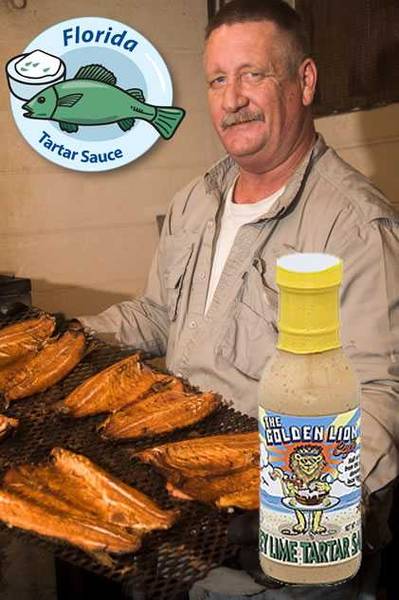
Tartar Sauce For Florida Smoked Mullet And Grilled Fish
Native Americans grilled and smoked all their meats. In the Caribbean and Florida, where the word barbecoa was first heard, smoked and grilled fish were the staple. Today, smoked mullet and grilled fish of all types are the classic barbecue dishes of the Sunshine State and in many ways the original indigenous American barbecue found here when Hernando deSoto waded ashore between St. Petersburg and Bradenton in 1539.
Today, mullet, an oily vegetarian fish that is caught in nets, is dusted with a spice rub, often Old Bay Seasoning straight from the can or a crab boil or a pork rub, and then smoked. That’s Mark Gullet above smoking mullet at the wonderful Star Fish Company Seafood Market in Cortez, FL, between St. Pete and Bradenton not far from where the Spanish first landed. The sign in his smokehouse says Mullet by Gullet.
Many folks eat the mullet like they eat ribs in Memphis, with rub only, no sauce. Many prefer smoked mullet spread, sometimes called fish salad, as in tuna salad, made from flaked smoked mullet mixed with tartar sauce, mayo, or cream cheese. It is served on crackers and sandwiches. They smoke other fish in Florida, but they are wise enough to know that fresh local fish don’t need smoke, they are best when simply grilled with salt, pepper, and maybe some butter or olive oil.
Sauce tartare as it was originally called in France, has been around a long time. It is in the same family as Italian aioli (garlicy mayo), or French sauce remoulade (mayo, herbs, capers, cornichons, and anchovies), both oil and egg based sauces. Thought to be named after the Tartars, Mongolian conquerors who roamed what is now Russia and its neighbors in the 5th century, the recipe hasn’t changed much over the years.
Serving
Serve as a dipping sauce with grilled or smoked fish, on salmon burgers, dip French fries in it (in Belgium and other much of France, they never use ketchup), batter fried fish, fried shrimp, fried chicken, even broccoli. Use it as a base for egg salad. You can slather it on the fish before you grill. It doesn’t melt off, it helps seal in moisture, and it can help prevent the fish from sticking to the grill grates. Finally, try it on a Reuben sandwich. You heard me.
Make your own
My tartar sauce recipe is based on mayo, pickle relish, and other goodies.
Buy a benchmark: Golden Lion Key Lime Tartar Sauce from Flagler Beach, FL
The Golden Lion Café is on the Atlantic just north of Daytona and has been named Florida’s Best Beach Bar many times since it was founded in 1993. Their chunky tartar sauce is made with mayonnaise, sweet relish, spices, a touch of ketchup gives it an orange color and a taste reminiscent of thousand island sauce, and it is enlivened with key lime juice.
Click here to order from Golden Lion
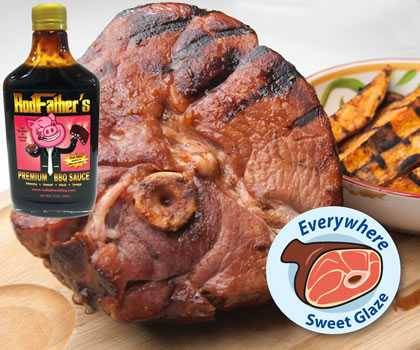
Sweet Glazes
In the past few years sweet glazes have become the single most popular taste profile on the competition barbecue circuit. The first ingredient on the list is usually brown sugar. Glazes are shiny so they make the meat glisten, and they are sweet/sour so they complement the pork and cut the fat.
Serving
Sweet shiny glazes are superb on pork chops and ham, but you will love this one on ribs, pulled pork, or even meatloaf.
Make your own
In New Mexico there’s a legendary pit stop where diners come out glazed over with Danny Gaulden’s Legendary Glaze and he has been generous enough to let me publish the recipe. Jazzy Hog Competition Barbecue Glaze is inspired by the most popular sauce on the competition barbecue circuit, Blues Hog Barbecue Sauce. Another fave is Chris Lilly’s Spiced Apricot Sauce, a killer glaze for ham created by the Executive Chef of Big Bob Gibson Bar-B-Q in Decatur, AL, and one of the best barbecue cooks I’ve ever known. He too, has shared his recipe with me.
Buy a benchmark: Blues Hog Barbecue Sauce from Perry, MO
In the past few years this sauce has become the single most popular taste profile on the competition barbecue circuit. A thoroughly creative and unusual sauce from the middle of nowhere in Perry, Missouri. Bill Arnold crafted this intriguing sauce from practically every herb and spice on his rack. Garnet colored, runny at room temp and thick from the fridge, it is laden with flecks of black pepper, green herbs, mustard seeds, chile peppers, a generous hit of cumin, and all manner of edible grit. It varnishes your meat with a glossy sheen and deep sea complexity. Sweet (brown sugar is the first item on the ingredients list), it is not unctuous because there are layers of red pepper heat, black pepper bite, nutty garlic, and grassy herbaceousness. One word or warning: Because it is so sweet, use only one layer. Multiple coats is too much.

Fruit And Flavored Sauces
Modern chefs are nothing if not creative, and just about anything you can imagine is used to make barbecue sauces. These sauces rarely have regional logic. There are a number of wonderful sauces that start out as start out as basic tomato based barbecue sauces and then are amped up with fruits, jams, and jellies as flavorizers and sweeteners. Raspberry, cherry, and apple are common. The work great with ribs.
Serving
Use fruit sauces on any type of pork or chicken, pour them on top of a meatloaf, or paint a thin glaze on a leg of lamb.
Make your own
Eve’s KC Pig Paint is a recipe of mine, a rich, sweet, Kansas City-style tomato-based sauce, with a secret ingredient from the Garden of Eden. Long ago I remember tasting a barbecue sauce tinged with cocoa, so I created my own Chocolate Chile Barbecue Sauce recipe.
Buy a benchmark: Ole Rays Ole Ray’s Blackberry Wine Barbecue & Cooking Sauce from St. Augustine, FL
This one is a thick dark nectar whose structure is similar to a KC sauce, but with a fruity flavor from blackberry jelly, and acidity from vinegar and lemon juice. This is not a novelty sauce. It has real richness and depth. Ole Ray’s makes a wide range of sauces and there are no slouches among them.
Other fun sauces
Here are some other fun sauces not included in the box of 12.

Dreamland Bar-B-Que Sauce (Tuscaloosa, AL). In 1958, John “Big Daddy” Bishop opened the Dreamland Café in Tuscaloosa, AL, the same year legendary football Coach Paul “Bear” Bryant arrived in Tuscaloosa. The ribs ascended to legendary, cooked fast but cooled with their thin flavorful sauce. The base is mostly vinegar and water, rounded out with tomato paste and mustard so it is a pale runny orange color that penetrates the meat and doesn’t just squat on it. The taste is tangy, tart, with a noticeable hot pepper spice that lingers looooonnng. It is more like a Lexington Dip than anything else. Not everyone will like this one, but I love it.
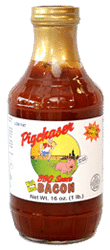
Pig Chaser BBQ Sauce with Real Bacon(Grayslake, IL). I’m really stretching it by saying there is a Chicago style because there really isn’t. If anything, many of the best of the Chicago sauces are garlicy derivitives of the Kansas City Style. But in the town that Carl Sandburg called “Hog Butcher to the World” this one is perfectly appropriate. This is the first, and to my knowledge, the only sauce to be allowed by USDA to have real bacon in the recipe. A dark brownish, very thick sauce with many dark bacon chunks swimming in solution. When you open it you smell bacon instantly, and that follows through to the taste. The owner has spared no expense including honey, pineapple juice, red wine vinegar, molasses, butter, and even maple syrup.
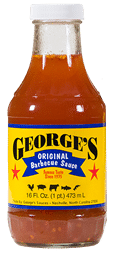
George’s Original Barbecue Sauce (Nashville, NC). A classic Lexington style sauce made in nearby Nashville, NC, George’s is mostly vinegar laced with hot red pepper, black pepper, and a whisp of ketchup. A touch of apple juice rounds it out nicely, making it my favorite of this style. It’s among my first choices for pulled pork. If you like vinegar, you’ll love George’s. Definitely not for everyone.

Black Swan Beso del Fuego. Chile peppers dominate the flavor of this thick rich garnet colored sauce, and there are some significant lumps floating around in there, but surprisingly it is not that hot. Yes, there is is a spiciness, it builds slowly and gradually in the back of the palate. Just right for someone like me who likes heat, but not pain.

Black Swan Sweet Cognac Sauce & Marinade (Dundee, IL). I was not only impressed with this sauce, I was impressed with the guy who made it, Max Good, so much that I hired him. Max is now the Director of the AmazingRibs.com Buyer’s Guides.
This fine sauce has a nice garnet/orange color with small black flecks, probably black pepper. The Cognac is so well integrated into the complex flavor that it is not an obvious component. Garlic and an orange flavor do stand out a bit, and I like that. It is more from the Kansas City sauce style mold than anything else. Black Swan is distributed in the US, Brazil, Costa Rica and the EU.
My favorite hot sauces
In Louisiana anything that can be put on a grill is called barbecue, from fish to crawfish to nutria (kinda like a rat). The first bottled hot sauces came out of Louisiana, home of Tabasco Sauce and in Louisiana, hot sauce goes on everything. But the classic New Orleans Barbecue Shrimp is served in a buttery hot sauce that is used to pan cook shrimp. It is served on rice or reaches its peak in a traditional sandwich called a po-boy. But it can also be used on andouille or other sausages, pork chops, pulled pork, or chicken.
Click here to read about my favorite hot sauces.

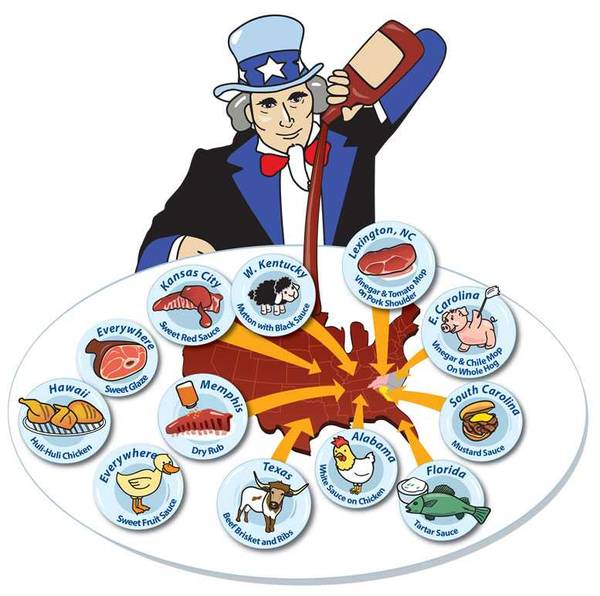

High quality websites are expensive to run. If you help us, we’ll pay you back bigtime with an ad-free experience and a lot of freebies!
Millions come to AmazingRibs.com every month for high quality tested recipes, tips on technique, science, mythbusting, product reviews, and inspiration. But it is expensive to run a website with more than 2,000 pages and we don’t have a big corporate partner to subsidize us.
Our most important source of sustenance is people who join our Pitmaster Club. But please don’t think of it as a donation. Members get MANY great benefits. We block all third-party ads, we give members free ebooks, magazines, interviews, webinars, more recipes, a monthly sweepstakes with prizes worth up to $2,000, discounts on products, and best of all a community of like-minded cooks free of flame wars. Click below to see all the benefits, take a free 30 day trial, and help keep this site alive.
Post comments and questions below
1) Please try the search box at the top of every page before you ask for help.
2) Try to post your question to the appropriate page.
3) Tell us everything we need to know to help such as the type of cooker and thermometer. Dial thermometers are often off by as much as 50°F so if you are not using a good digital thermometer we probably can’t help you with time and temp questions. Please read this article about thermometers.
4) If you are a member of the Pitmaster Club, your comments login is probably different.
5) Posts with links in them may not appear immediately.
Moderators